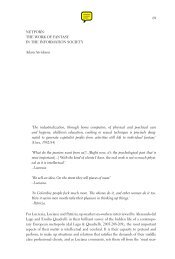Nakamura, Digitizing Race, Introduction, chapter 5, Epilogue
Nakamura, Digitizing Race, Introduction, chapter 5, Epilogue
Nakamura, Digitizing Race, Introduction, chapter 5, Epilogue
Create successful ePaper yourself
Turn your PDF publications into a flip-book with our unique Google optimized e-Paper software.
Avatars and the Visual Culture of Reproduction 143<br />
to the principles of “cleanness” and masculinity that dominated digital culture<br />
in its early years. Rather than “toning it down,” their digital signatures<br />
tend to do exactly the opposite, mixing media and textures and ornamentation<br />
in a fashion that defies these notions of good taste and embodies “tackiness”<br />
as exemplified by the lower-class taste cultures reviled by the modernists<br />
cited earlier. In addition, the form of these sites challenges the bourgeoisindividualist<br />
model of property and presence that characterized early cyberspace’s<br />
rhetoric. This rhetoric of ownership and triumphant individualism<br />
inherent in much of the electronic frontier discourse has since been critiqued<br />
from both feminist and postcolonial perspectives. The notion that<br />
representational and cultural power could arise only from the staking out of<br />
individual spaces or “homesteads” on the Internet privileged singly owned,<br />
managed, and designed Web sites or “home pages” as “domains” or sites of<br />
identity. Susan Leigh Star critiques this notion of the home-page-as-home because<br />
it requires an amount of cultural and real capital unattainable to many;<br />
ironically, as she notes, academic nomads such as herself may be among the<br />
few who can afford to be figuratively situated or “homed” in cyberspace<br />
through the ownership and control of a personal site. She also notes that<br />
technology, the Web included, has often resulted in “more work for mother”<br />
rather than less and has also created more rather than less isolation for<br />
women, who are often stuck at home in caregiving roles. 23 However, the<br />
figuration of the individual home page, a space that Nina Wakeford notes<br />
can reduplicate the endless housekeeping and drudgery of domestic upkeep<br />
just as does the offline home, has since lost much of its cachet as a source of<br />
digital visual capital on the popular graphical Internet. Despite early predictions<br />
such as Star’s and Wakeford’s, which were published in 1996 on the<br />
eve of the World Wide Web’s massification, the individual home page has not<br />
turned out to be the main or even dominant route to independent expression<br />
in terms of the Internet’s visual culture. Web sites like babydream.com<br />
maintain or “host” discussion boards that permit users to create individual<br />
posts or spaces of visual digital identity within the confines of a shared virtual<br />
space. This model of shared rather than personal space, characteristic<br />
of blogging and online journaling spaces such as LiveJournal, which have<br />
also often been identified with female users, allows a model of digital participation<br />
and cross-linkage that requires less technical skill than is necessary<br />
to create a single stand-alone Web site, thus creating less work for<br />
mother and easier navigation between different users’ virtual spaces of expression.<br />
While an individual Web site may constitute a burden, a virtual<br />
“room of one’s own” in the form of a digital signature, even an elaborate





